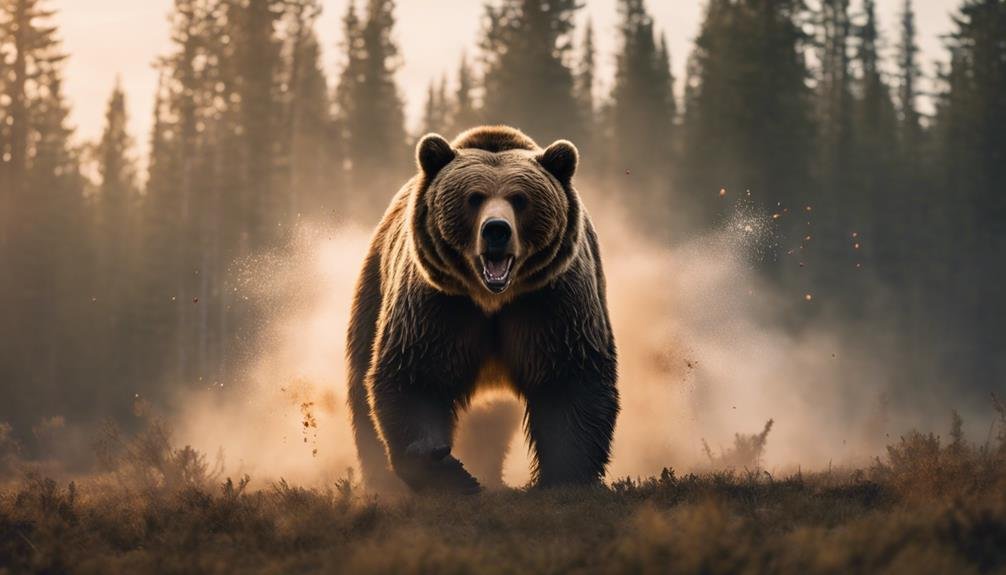When venturing into grizzly bear habitats, outdoor enthusiasts face a critical decision: trust their safety to non-lethal bear spray or opt for the lethal stopping power of a pistol. Each choice carries distinct implications for human and bear welfare. Bear spray is a non-lethal deterrent that creates a temporary barrier, but has limitations such as wind direction, range, and duration of effectiveness. Pistols provide a precise and immediate response, but require proper training and concealed carry practices. Understanding the pros and cons of each approach enables informed decisions aligned with individual values and priorities. As you prepare for your next wilderness adventure, exploring the nuances of these options can be a matter of life and death.
Key Takeaways
- Bear spray is a non-lethal deterrent that creates a temporary barrier between the user and the bear, with a 90% effectiveness rate.
- Pistols, particularly .357 Magnum revolvers, offer a precise and immediate response to a bear attack, but require proper training and concealed carry practices.
- The survival rate for individuals using bear spray is approximately 98%, while those using pistols have a substantially lower survival rate of around 76%.
- Wind direction, range, and duration of effectiveness are limitations of bear spray, and considering these factors is crucial when deploying it.
- Familiarity and proficiency with bear spray or firearms play a significant role in determining personal defense preferences in bear country.
Grizzly Country Safety Essentials
Venturing into grizzly country demands a well-thought-out safety strategy, incorporating essential elements that prioritize preparedness and confidence. Grizzly habitats, characterized by dense vegetation and rugged terrain, require outdoor enthusiasts to adopt responsible outdoor ethics. This includes being aware of their surroundings, making noise while hiking, and staying in groups. It is vital to recognize that grizzly bears are wild animals that deserve respect and caution. By understanding their behavior and habitat, outdoor enthusiasts can minimize the risk of encounters. A safety strategy should also include knowledge of local regulations, carrying appropriate gear, and having a plan in place for emergency situations. By prioritizing preparedness and confidence, individuals can safely coexist with grizzly bears in their natural habitats.
Non-Lethal Vs Lethal Options
When trekking through grizzly country, outdoor enthusiasts are often faced with the crucial decision of choosing between non-lethal and lethal options for self-defense, each with its unique advantages and limitations. This choice presents moral dilemmas and ethical deliberations, as individuals must weigh the potential consequences of their actions. Non-lethal options, such as bear spray, prioritize the safety of both humans and bears, while lethal options, like firearms, may be viewed as a last resort. It is essential to ponder the context and circumstances of an encounter, as well as personal comfort levels, when deciding between these options. By understanding the pros and cons of each approach, outdoor enthusiasts can make informed decisions that align with their values and priorities.
Understanding Bear Spray
Bear spray, a non-lethal deterrent, has become a popular choice among outdoor enthusiasts venturing into grizzly country, largely due to its ease of use and proven effectiveness in deterring aggressive bears. When deployed correctly, bear spray can create a temporary barrier between the user and the bear, providing time to slowly back away and leave the area. However, you must understand the limitations of bear spray, including wind direction, range, and duration of effectiveness.
| Spray Effectiveness | Spray Limitations | Best Practices |
|---|---|---|
| 90% effective in deterring bears | Wind direction affects spray spread | Always carry bear spray with you |
| Easy to use, even for non-experienced users | Limited range (6-8 meters) | Practice deploying bear spray before heading out |
| Non-lethal, reducing risk of fatalities | Duration of effectiveness (30-45 seconds) | Consider wind direction when deploying spray
The Pistol Advantage
How does a pistol, particularly a .357 Magnum revolver, offer a distinct advantage in stopping a charging grizzly bear, especially in close-range encounters where bear spray may be less effective? A pistol provides a precise and immediate response to a bear attack, allowing for a more targeted defense. In contrast, bear spray can be affected by wind direction and may not be as effective in close quarters. Proper pistol training and concealed carry practices are essential to facilitate effective use in high-stress situations. With a pistol, the user has more control over the situation, allowing for a more deliberate and precise response. This can be particularly important in dense vegetation or when faced with a surprise attack.
Survival Rate Statistics
Statistics demonstrate that the choice of self-defense method substantially impacts the survival rate of individuals attacked by grizzly bears. Fatal attacks are more likely to occur when individuals rely solely on pistols, with a notably lower survival rate compared to those using bear spray. In fact, studies have shown that the survival rate for individuals using bear spray is approximately 98%, whereas those using pistols have a substantially lower survival rate of around 76%. This disparity can be attributed to the increased likelihood of misfires, accidents, and poor aim when using firearms in high-stress situations. Conversely, bear spray has proven to be a more effective and reliable deterrent, resulting in higher attack survivability rates.
Personal Defense Preferences
Individuals venturing into grizzly bear country often develop unique preferences for personal defense, shaped by their experiences, comfort levels, and perceived risks. This personalization is essential, as it directly influences one's bear anxiety and overall sense of personal comfort.
Three key factors contribute to these preferences:
- Comfort with technology: Familiarity and proficiency with bear spray or firearms play a significant role in determining personal defense preferences.
- Exposure to bear encounters: Individuals who have had close encounters with grizzly bears may prefer more aggressive defense methods, while those with limited exposure may opt for non-lethal deterrents.
- Perceived risk assessment: Personal risk assessment influences the choice between bear spray and firearms, with some individuals prioritizing convenience and others emphasizing effectiveness in high-stress situations.
Wilderness Threats Beyond Bears
While grizzly bears often dominate the conversation surrounding wilderness threats, other wildlife species, such as black bears, moose, and mountain lions, can also pose significant dangers to outdoor enthusiasts. Mountain lions, in particular, are known to inhabit areas with dense vegetation, making it essential to be aware of their presence when hiking or hunting in these regions. Wildlife corridors, designed to facilitate animal migration, can also increase the likelihood of encounters with these species. It is vital to recognize that each species presents unique threats and requires tailored defensive strategies. By acknowledging and preparing for these threats, outdoor enthusiasts can minimize the risk of encounters and have a safe and enjoyable wilderness experience.
Conservation and Management
Effective conservation and management strategies are essential to maintaining a delicate balance between human recreation and wildlife populations in grizzly bear country. Wildlife reserves and conservation efforts play a pivotal role in preserving habitats and ensuring the long-term survival of grizzly bears and other wildlife species.
- Habitat preservation: Protecting and restoring natural habitats is essential for maintaining healthy wildlife populations.
- Regulated hunting and fishing: Implementing sustainable hunting and fishing practices helps maintain a balance between human recreation and wildlife populations.
- Research and monitoring: Continuous research and monitoring of wildlife populations and habitats inform effective conservation and management strategies.
Responsible Recreation Practices
Practicing responsible recreation in grizzly bear country requires a thoughtful and informed approach to minimize the risk of encounters with wildlife. By adopting Wildlife Etiquette and embracing Eco Tourism principles, outdoor enthusiasts can enjoy the beauty of nature while promoting a harmonious coexistence with grizzly bears.
| Responsible Recreation Practices | Benefits |
|---|---|
| Make noise while hiking | Avoid surprising bears |
| Keep a clean campsite | Reduce attractants |
| Store food and trash properly | Prevent habituation |
| Travel in groups | Increase visibility |
| Be aware of surroundings | Improve situational awareness |
Real-Life Self-Defense Stories
Real-life encounters with grizzly bears serve as poignant reminders of the importance of being prepared for self-defense situations in the wilderness. Hunting stories and bear attacks can be valuable learning experiences for outdoor enthusiasts. Here are three real-life examples:
- Archery Elk Hunter Survives Grizzly Attack: In Idaho, an archery elk hunter killed a charging grizzly bear in self-defense, highlighting the importance of being prepared for unexpected encounters.
- Teenager Defends Himself Against Brown Bear: In Alaska, a 19-year-old hunter killed a brown bear in self-defense with a .44 Mag. revolver, demonstrating the effectiveness of firearms in high-stress situations.
- Grizzly Bear Attack on Hikers: In Montana, a group of hikers successfully defended themselves against a grizzly bear attack using bear spray, emphasizing the importance of carrying and knowing how to use bear deterrents.
These stories underscore the need for awareness, preparation, and responsible recreation practices in bear country.
Choosing the Right Gear
When venturing into grizzly bear country, selecting the appropriate gear is crucial, as it can greatly impact the outcome of a potentially life-threatening encounter. Choosing the right gear can provide gear confidence, allowing individuals to focus on their outdoor mindset. The decision between bear spray and a pistol depends on personal preference, comfort level, and the situation.
| Gear Option | Advantages | Disadvantages |
|---|---|---|
| Bear Spray | Non-lethal, easy to use, and convenient to carry | Limited range, affected by wind direction |
| Pistol | Can be effective in close-range encounters | Requires steady nerves and solid aim |
| Combination | Provides multiple options for varying situations | Increased weight and bulk |
Ultimately, the key to successful gear selection is understanding individual needs and preferences, and being prepared for any situation that may arise in grizzly bear country.
Frequently Asked Questions
Can I Use Bear Spray on Other Aggressive Wildlife Besides Bears?
While bear spray is specifically designed to deter aggressive bears, its effectiveness on other wildlife is uncertain. However, in encounters with other predators, such as mountain lions or wolves, bear spray may still be a viable deterrent, but its efficacy depends on various factors, including predator behavior and wind conditions.
Are There Any Age Restrictions for Carrying Bear Spray or Pistols?
In the United States, age restrictions for carrying bear spray or pistols vary by state, often requiring legal guardians or parental consent for minors, with some states having specific laws governing youth hunting and outdoor activities.
How Often Should I Replace My Bear Spray Canister?
Bear spray canisters typically have an expiry date or shelf life of 3-4 years, after which the potency and effectiveness may decrease; it's essential to check the manufacturer's guidelines and replace the canister accordingly to ensure optimal performance.
Can I Use Bear Spray in Enclosed or Confined Spaces?
When considering bear spray use in enclosed or confined spaces, prioritize tunnel safety and be aware of elevator risks, as the spray's effectiveness and potential backdraft hazards may be compromised in these environments.
Are There Any Specific Clothing or Gear Recommendations for Bear Country?
When venturing into bear country, consider wearing clothing and gear made from wilderness fabrics that resist tears and punctures, and store food and scented items in bear-proof bags to minimize attractants and reduce the risk of encounters.
Conclusion
In the vast expanse of grizzly bear country, where towering peaks give way to dense forests and winding rivers, the decision between bear spray and pistols as a deterrent hangs precariously in the balance. As the landscape shifts from tranquility to turmoil, the choice between non-lethal and lethal options crystallizes. Ultimately, it is the informed outdoorsperson, armed with knowledge and prudence, who will navigate the treacherous terrain of bear country, where safety and responsibility converge.









